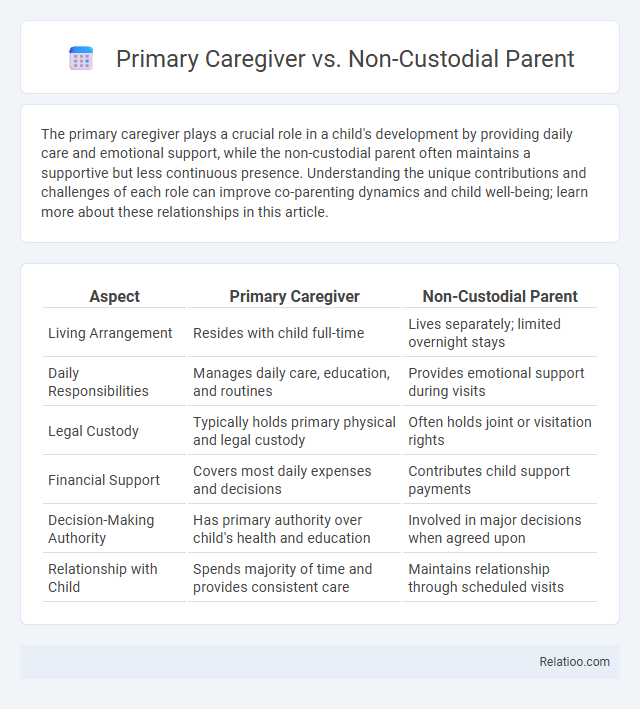The primary caregiver plays a crucial role in a child's development by providing daily care and emotional support, while the non-custodial parent often maintains a supportive but less continuous presence. Understanding the unique contributions and challenges of each role can improve co-parenting dynamics and child well-being; learn more about these relationships in this article.
Table of Comparison
| Aspect | Primary Caregiver | Non-Custodial Parent |
|---|---|---|
| Living Arrangement | Resides with child full-time | Lives separately; limited overnight stays |
| Daily Responsibilities | Manages daily care, education, and routines | Provides emotional support during visits |
| Legal Custody | Typically holds primary physical and legal custody | Often holds joint or visitation rights |
| Financial Support | Covers most daily expenses and decisions | Contributes child support payments |
| Decision-Making Authority | Has primary authority over child's health and education | Involved in major decisions when agreed upon |
| Relationship with Child | Spends majority of time and provides consistent care | Maintains relationship through scheduled visits |
Understanding the Role of a Primary Caregiver
The primary caregiver is the individual responsible for the day-to-day care and emotional support of a child, often providing consistent nurturing and meeting the child's basic needs such as health, education, and safety. In contrast, a non-custodial parent typically has visitation rights but does not hold the primary responsibility for daily caregiving tasks or decision-making authority regarding the child's welfare. Understanding the role of the primary caregiver highlights the essential impact they have on a child's development and stability, irrespective of legal custody status.
Defining the Non-Custodial Parent
The non-custodial parent is the parent who does not have primary physical custody of a child but often retains visitation rights and contributes to financial support. Unlike the primary caregiver, who is responsible for day-to-day child-rearing tasks, the non-custodial parent's involvement may be limited to scheduled times and shared decision-making. Understanding your role as a non-custodial parent is essential for maintaining a positive and supportive relationship with your child.
Legal Differences Between Primary Caregivers and Non-Custodial Parents
Legal differences between primary caregivers and non-custodial parents primarily revolve around custody rights and decision-making authority. The primary caregiver typically holds legal custody, granting the authority to make critical decisions about the child's education, healthcare, and welfare, while the non-custodial parent often has visitation rights but limited decision-making power. Your legal responsibilities and rights as a primary caregiver ensure greater control over the child's upbringing compared to the more restricted role of a non-custodial parent.
Responsibilities of a Primary Caregiver
The primary caregiver assumes the main responsibility for the daily care, emotional support, and physical well-being of the child, including managing health appointments, education, and nutrition. Unlike a non-custodial parent, who typically has visitation rights and limited decision-making authority, the primary caregiver often makes critical decisions regarding the child's upbringing. Custodial status legally designates the individual responsible for the child's care, but the primary caregiver role focuses on the practical, hands-on duties essential for the child's development.
Rights and Duties of Non-Custodial Parents
Non-custodial parents typically have visitation rights and are responsible for child support payments, ensuring the child's financial needs are met despite not living with them full-time. Your legal rights include regular visitation schedules and access to important information about the child's education and health, while your duties often involve maintaining consistent communication and supporting the child's well-being emotionally and financially. Courts prioritize the child's best interests when enforcing these rights and duties, balancing both parental roles effectively.
Co-Parenting and Communication Strategies
Primary caregivers typically manage daily child-rearing responsibilities, while non-custodial parents often focus on maintaining meaningful involvement despite less physical custody. Effective co-parenting requires clear, consistent communication strategies, such as scheduled check-ins, shared parenting apps, and respectful dialogue prioritizing the child's well-being. Establishing boundaries and mutual respect enhances collaboration, reducing conflict and fostering a stable environment for the child.
Impact on Child Development and Wellbeing
Primary caregiver roles significantly influence a child's emotional security and cognitive growth, with consistent nurturing from the primary caregiver fostering better psychological development and attachment. Non-custodial parents often face challenges in maintaining strong bonds, which can affect the child's sense of stability and wellbeing if frequent interaction is limited. Your involvement as either caregiver type directly impacts the child's social skills and resilience, emphasizing the importance of quality time and positive communication for optimal development.
Navigating Child Support and Financial Obligations
The primary caregiver typically assumes the majority of child support responsibilities due to providing daily care and expenses, while the non-custodial parent is usually required to fulfill financial obligations through court-ordered payments. Understanding state guidelines on child support calculations is crucial for both parties to ensure fair distribution of financial duties. Effective communication and legal counsel can help navigate complexities related to modifications, enforcement, and shared expenses between primary caregivers and non-custodial parents.
Common Challenges Faced by Both Roles
Both primary caregivers and non-custodial parents commonly face challenges such as maintaining effective communication, managing co-parenting conflicts, and ensuring the child's emotional stability during transitions. You must navigate scheduling complexities and differing parenting styles while prioritizing the child's well-being and consistent routines. Emotional stress and balancing parental responsibilities often affect both roles despite their differing day-to-day involvement.
Building a Positive Relationship for the Child
Building a positive relationship for the child involves understanding the distinct roles of the primary caregiver, non-custodial parent, and primary caregiver in shared custody arrangements. Your commitment to consistent communication and cooperation fosters emotional security, while recognizing each caregiver's contributions strengthens the child's sense of stability and trust. Prioritizing the child's well-being through mutual respect and open dialogue supports healthy development and resilience.

Infographic: Primary caregiver vs Non-custodial parent
 relatioo.com
relatioo.com